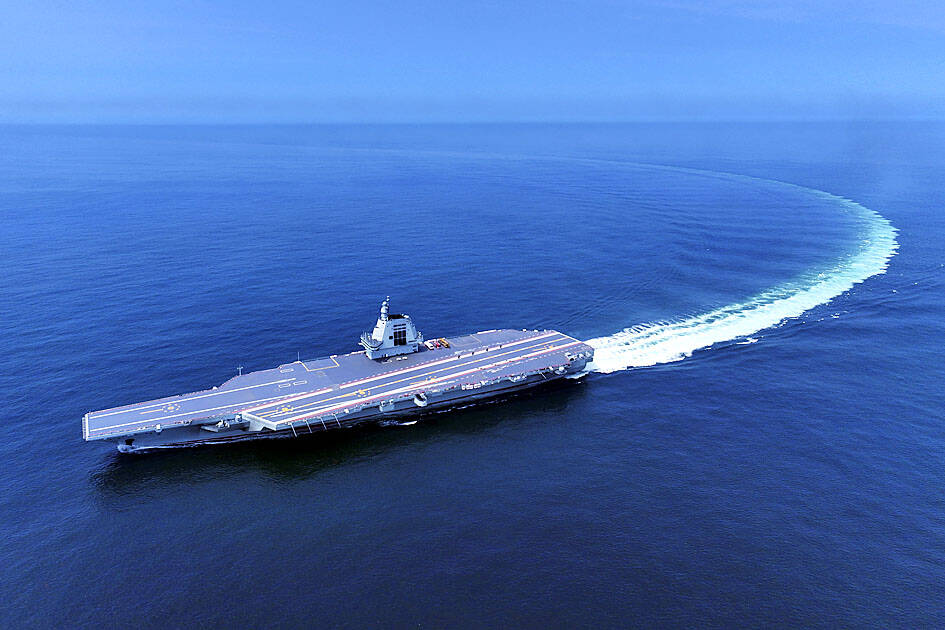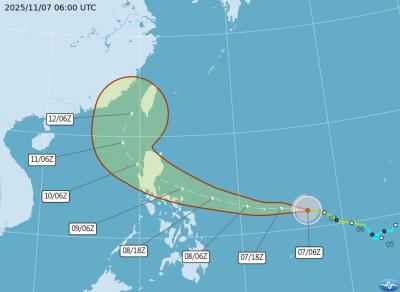The Chinese People’s Liberation Army Navy’s (PLAN) third aircraft carrier, the Fujian, would pose a steep challenge to Taiwan’s ability to defend itself against a full-scale invasion, a defense expert said yesterday.
Institute of National Defense and Security Research analyst Chieh Chung (揭仲) made the comment hours after the PLAN confirmed the carrier recently passed through the Taiwan Strait to conduct “scientific research tests and training missions” in the South China Sea.
China has two carriers in operation — the Liaoning and the Shandong — with the Fujian undergoing sea trials.

Photo: Xinhua via AP
Although the PLAN needs time to train the Fujian’s air wing and integrate the ship into its carrier strike group, a third Chinese aircraft carrier would lead to a quantitative and qualitative shift in the cross-strait military balance, he said.
With a trio of carriers, the PLAN could simultaneously deploy a strike group in the seas east of Taiwan, train a strike group in the South China Sea and refit the remaining group at base, Chieh said.
This would upturn Taiwan’s long-held plans and assumptions about fighting a war with China, he added.
The Taiwan-US strategy of utilizing the Miyako Strait, Bashi Channel and Balintang Channel as chokepoints to stop the PLAN’s advance to the West Pacific could be nullified if a Chinese carrier was already patrolling beyond that line, he said.
A carrier strike group fighting outside these strategic waterways would have room to deploy a defensive formation, significantly degrading the effectiveness of Taiwanese anti-ship capabilities, Chieh said.
The navy’s force preservation plan depends on getting into tactical positions in the West Pacific upon detecting signs of an invasion, while the air force expects to be able to shelter its fighter jets in underground hangars in Hualien and Taitung, he said.
A Chinese carrier strike group lying in wait to Taiwan’s east would be able to engage Taiwanese navy vessels and outflank the eastern air bases from a direction not protected by the Central Mountain Range, Chieh said, adding that the Chinese armed forces would then have an opportunity to destroy the bulk of Taiwan’s sea and air power in the opening moves of a war.
The Fujian’s ability to launch fixed-wing airborne early warning and control systems (AWACS) is an upgrade from the Liaoning and Shandong, which rely on rotary-wing AWACS for defense, he said.
Assuming the Xian KJ-600 AWACS could be launched from the decks of the Fujian, it would be capable of establishing a 600km-deep defensive perimeter, compared with the Shandong’s range of between 185km and 400km, Chieh said.
Taiwan’s longest-range air-launched anti-ship missile is the AGM-84K SLAM-ER, which has a reach of 270km, so the fighter jet must be within 350km to 400km from the Fujian to mount an attack, he said.
That would put the launch platform well within the range of the Chinese carrier strike group’s combat air patrol and air defense systems, he added.

The Central Weather Administration (CWA) today issued a sea warning for Typhoon Fung-wong effective from 5:30pm, while local governments canceled school and work for tomorrow. A land warning is expected to be issued tomorrow morning before it is expected to make landfall on Wednesday, the agency said. Taoyuan, and well as Yilan, Hualien and Penghu counties canceled work and school for tomorrow, as well as mountainous district of Taipei and New Taipei City. For updated information on closures, please visit the Directorate-General of Personnel Administration Web site. As of 5pm today, Fung-wong was about 490km south-southwest of Oluanpi (鵝鑾鼻), Taiwan's southernmost point.

Tropical Storm Fung-Wong would likely strengthen into a typhoon later today as it continues moving westward across the Pacific before heading in Taiwan’s direction next week, the Central Weather Administration (CWA) said. As of 8am, Fung-Wong was about 2,190km east-southeast of Cape Oluanpi (鵝鑾鼻), Taiwan’s southernmost point, moving westward at 25kph and possibly accelerating to 31kph, CWA data showed. The tropical storm is currently over waters east of the Philippines and still far from Taiwan, CWA forecaster Tseng Chao-cheng (曾昭誠) said, adding that it could likely strengthen into a typhoon later in the day. It is forecast to reach the South China Sea

Almost a quarter of volunteer soldiers who signed up from 2021 to last year have sought early discharge, the Legislative Yuan’s Budget Center said in a report. The report said that 12,884 of 52,674 people who volunteered in the period had sought an early exit from the military, returning NT$895.96 million (US$28.86 million) to the government. In 2021, there was a 105.34 percent rise in the volunteer recruitment rate, but the number has steadily declined since then, missing recruitment targets, the Chinese-language United Daily News said, citing the report. In 2021, only 521 volunteers dropped out of the military, the report said, citing

Nearly 5 million people have signed up to receive the government’s NT$10,000 (US$322) universal cash handout since registration opened on Wednesday last week, with deposits expected to begin tomorrow, the Ministry of Finance said yesterday. After a staggered sign-up last week — based on the final digit of the applicant’s national ID or Alien Resident Certificate number — online registration is open to all eligible Taiwanese nationals, foreign permanent residents and spouses of Taiwanese nationals. Banks are expected to start issuing deposits from 6pm today, the ministry said. Those who completed registration by yesterday are expected to receive their NT$10,000 tomorrow, National Treasury